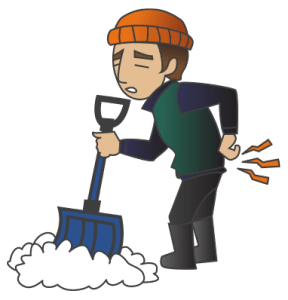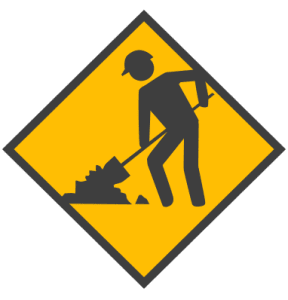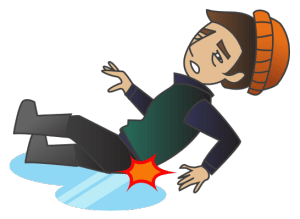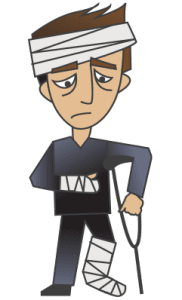As fall begins, it’s a good time to take stock of the steps your place of business should take to prevent winter hazards that lead to slip-and-fall accidents.
Slip-and-fall accidents are among the most frequent causes of injury in the American workplace. The Occupational Safety and Health Administration (OSHA) says that falls are the number one cause of death in construction work. The National Institute for Occupational Safety and Health (NIOSH) says fatal falls are the most frequent cause of nonfatal injuries in the health services, wholesale and retail industries. NIOSH say that medical expenses and workers’ compensation costs associated with occupational injuries suffered in falls amount to about $70 billion annually in the United States. NSH Hospitality, an insurance underwriter for the hotel and resort industry, says slip-and-fall accidents are the most common claims they receive, accounting for 30 percent of all insurance claims and producing average payouts of more than $14,000 per claim.
Workers can be hurt in slip- and trip-and-fall accidents in any kind of walkway, and by falls from elevated surfaces and work stations or into holes in the floor, in the ground, on roofs or paved surfaces.
In addition to construction or demolition job sites, where many fall hazards can be expected, workers – as well as customers or any business visitor – can be injured in a fall at:
Slip-and-fall hazards can be exacerbated by winter weather that causes snow, ice and slush to build up on outside surfaces and/or to be tracked into buildings to make surfaces slippery. Black ice creates a hidden hazard on hard surfaces. Snow drifts or other accumulation can fill and disguise potholes, obscure changes in surface levels, like curbs, or cover debris and other clutter that creates a tripping hazard.
Winter’s freeze-thaw cycle can also damage outdoor walkways and make them unsafe, such as by warping wooden stairs and breaking up hardscape surfaces when water seeps into cracks, freezes and expands.
Added hours of darkness in the winter can leave areas with stairs, curbs or other changes in elevation poorly lit and treacherous, increasing the risk of a fall, especially if lighting timers are not adjusted for the change in season or the end of daylight savings time.
You can plan now to ensure that winter weather does not lead to an unnecessary sip-and-fall injury and the ensuring medical costs, loss of work time and other headaches for you, your workers and your business. Your workplace should have established policies, procedures and assigned responsibilities for mitigating weather-related fall hazards.
Here are four steps to take to guard against slip-and-fall accidents this winter:
 Ensure prompt snow and ice removal. Shovel, plow or treat with salt or sawdust snow and ice on walkways, driveways, parking lots and other common areas in a timely manner after snowfalls and ice storms. Many cities and town have local ordinances requiring removal within a certain amount of time after snowfall or other inclement weather ends.
Ensure prompt snow and ice removal. Shovel, plow or treat with salt or sawdust snow and ice on walkways, driveways, parking lots and other common areas in a timely manner after snowfalls and ice storms. Many cities and town have local ordinances requiring removal within a certain amount of time after snowfall or other inclement weather ends.
 Ensure that lobbies and other entrances are mopped and dried. Policies should ensure prompt response to the potential for wet and slippery floors in inclement weather, and include monitoring high-traffic areas during business hours. Provide water-absorbent mats at entrances and umbrella bags to keep rainwater from dripping onto floors. Keep in mind that simply setting out a wet floor sign doesn’t necessarily protect the property owner against liability if someone slips and is injured.
Ensure that lobbies and other entrances are mopped and dried. Policies should ensure prompt response to the potential for wet and slippery floors in inclement weather, and include monitoring high-traffic areas during business hours. Provide water-absorbent mats at entrances and umbrella bags to keep rainwater from dripping onto floors. Keep in mind that simply setting out a wet floor sign doesn’t necessarily protect the property owner against liability if someone slips and is injured.
 Repair existing hazards. Before winter arrives, check the premises including the grounds around your building. Repair potholes, broken pavement, loose tile, torn carpet, loose or broken handrails or stair treads. Instruct workers to clean up debris or equipment stored haphazardly or in walkways. Check lighting and repair outages, and create automated notices to remind you to adjust timers. Continue to conduct regular inspections for hazards and see to it that any hazards are repaired as quickly as possible.
Repair existing hazards. Before winter arrives, check the premises including the grounds around your building. Repair potholes, broken pavement, loose tile, torn carpet, loose or broken handrails or stair treads. Instruct workers to clean up debris or equipment stored haphazardly or in walkways. Check lighting and repair outages, and create automated notices to remind you to adjust timers. Continue to conduct regular inspections for hazards and see to it that any hazards are repaired as quickly as possible.
 Train and equip workers. OSHA has training and protective gear requirements for workers in construction and other potentially hazardous industries, which should be followed, but all workers need to understand potential slip-and-fall hazards. In offices, for example, proper step stools or small ladders should be available for employees who must reach or climb to store or retrieve supplies, and they should be instructed not to use chairs, boxes or other unstable substitutes. Office workers should not leave briefcases, boxes, files, or other equipment in aisles, and should avoid stringing cords across walkways. Make sure employees know how to report a hazard that needs to be cleaned up or repaired.
Train and equip workers. OSHA has training and protective gear requirements for workers in construction and other potentially hazardous industries, which should be followed, but all workers need to understand potential slip-and-fall hazards. In offices, for example, proper step stools or small ladders should be available for employees who must reach or climb to store or retrieve supplies, and they should be instructed not to use chairs, boxes or other unstable substitutes. Office workers should not leave briefcases, boxes, files, or other equipment in aisles, and should avoid stringing cords across walkways. Make sure employees know how to report a hazard that needs to be cleaned up or repaired.

Property owners have a legal responsibility to ensure the reasonable safety of visitors, including a requirement to remove or mitigate hazards in a timely manner or to adequately warn of their existence. In winter months in states like Kentucky, Ohio and Indiana, this translates into dealing with ice, snow and other inclement weather hazards in a timely manner. Slip- and trip-and-fall hazards should be a year-round concern at your place of business.
Workers who are injured in slip-and-fall accidents while on the job typically qualify for workers’ compensation insurance benefits. Customers and other visitors may seek payments through the property owner’s business liability insurance. These costs may not come out of a business owner’s pocket, but will typically result in higher insurance premiums. And of course, beyond the financial consequences, we should all be concerned about the potentially crippling injuries suffered in slip-and-fall accidents.
The Becker Law Office helps residents of Kentucky, Tennessee, Indiana and Ohio obtain compensation for medical costs and other losses suffered in slip-and-fall accidents caused by property owners’ negligence. If you have suffered a significant injury in a fall that was not your fault, we can discuss your legal options with you in a free consultation. If we can pursue a claim on your behalf, we will do so aggressively. Contact us for help today.